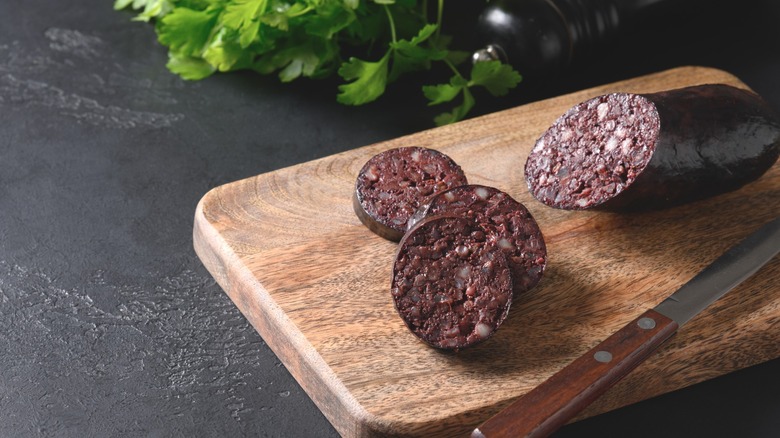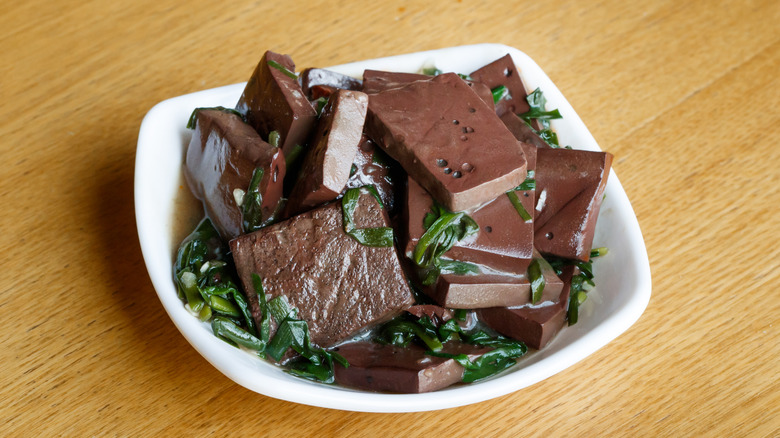Why Aren't More Americans Cooking With Blood? Everyone Else Is Doing It
Let's cut to the chase: Blood is an important element of cuisines across the globe. There's German blutwurst, Scandinavian blodplättar pancakes, Vietnamese tiết canh blood soup, and Chinese blood tofu, to name just a few diverse and delicious blood-centric dishes. Blood, in the form of black pudding, an indispensable element of a traditional full English breakfast, is even a component of Gordon Ramsay's legendary, ideal last meal. There are several reasons why blood gets so much cross-cultural love. It's protein-packed, rich in iron, and delicious. (Speaking from personal experience, Spanish morcilla blood sausage adds a delightfully complex rich and savory flavor to fabada Asturiana.)
While cooking with blood isn't exactly taboo in modern American culture, it's certainly not mainstream. Americans' stereotypical penchant for well-done meat suggests that we don't even want to see blood (although the red juices in a rare steak aren't actually blood). No matter how you slice it, cooking and eating blood remains relatively uncommon in the United States and carries a certain "ick" factor for many Americans.
Consuming blood is taboo in some cultures for religious reasons, but why American kitchens remain so bloodless is less clear. Some suggest it's due to the rise of industrial meat production which makes accessing fresh, unspoiled blood more complicated. (That being said, blood is a popular ingredient in many countries with established systems of industrial meat production.) Another popular explanation for Americans' aversion to blood is our preference for convenient, perfectly packaged fare. American cuisine is not just fast food, TV dinners, and hot dogs (which actually originated in Europe), but these stereotypes come from somewhere.
Why blood might be the next superfood
Of course, people do cook with blood in the United States. Many groups of immigrants have brought diverse culinary traditions involving blood to the U.S., and some Native American tribes have a history of cooking with blood as well. However, blood and blood-containing food products are usually only available at specialty stores and remain a rare find on American restaurant menus. Despite this, the ingredient has become increasingly popular with chefs in recent years. Blood is about as natural as it gets and requires a certain level of care and skill to prepare properly. Many chefs enjoy cooking with blood precisely because it's simultaneously challenging and rewarding to work with.
In addition to being delicious, blood is also quite nutritious. Blood consists mainly of protein and water, making it a fabulous source of lean protein. Blood is also rich in heme iron which is the easiest type of iron for our bodies to absorb. If that wasn't enough, blood also boasts a generous dose of vitamin D and is very low in cholesterol. What's more, cooking with blood is a great way to reduce food waste; it would otherwise get thrown away or be used to make animal feed. Because of this, using blood is a perfect example of nose-to-tail cooking.
Although blood has yet to become a supermarket staple stateside, it's never too late for Americans to hop on the blood bandwagon. Protein-rich, nutritious, sustainable, and unprocessed, blood boasts all the components of a trendy superfood. So who knows? Americans just might be seeing a lot more blood on their plates in the coming years.

